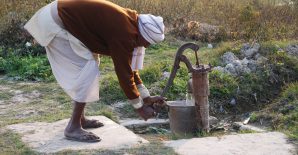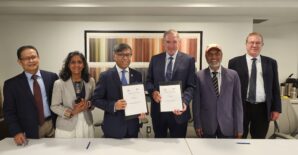To mark International Women’s Day—with the theme “Rural and Urban Activists Transforming Women’s Lives”—IFPRI is examining the role of rural women activists in bringing change to nutrition and food systems worldwide. This is the second of two posts—read the first here.
Women’s groups are increasingly becoming vehicles for social, political, and economic empowerment around the world. In India, self-help groups (SHGs) are the most visible of these, receiving support from NGOs, the government, and even the private sector. Each SHG typically consists of 10-20 poor women who live near each other, meet regularly, and save small amounts of money in a common account.

Alejandra Arrieta/IFPRI
Women attend a event organized by a self-help group in the village of Basaniya in Madhya Pradesh, India, to discuss recent training sessions in nutrition.
To better understand how SHGs work and how to make their programs more effective, we are working with one of India’s largest NGOs, PRADAN, to examine the impact of layering nutrition-sensitive interventions on their existing agricultural-livelihoods program platform. The four-year research effort is called Women Improving Nutrition through Group-based Strategies (WINGS).
Our study is ongoing, but some early results, based on data from a 2015 survey in five states, indicate SHGs likely do help empower women by enhancing their mobility, building their self-confidence, and providing them with more powerful social networks.
SHGs reduce the cost of delivering information to poor women who might be unaware of public benefits or be excluded from government services such as agricultural extension and information services. For instance, if an SHG actively promotes specific health- and nutrition-related programs, that can increase demand and produce better coordination with community health workers. These groups can also help expand social networks and the communication within them—facilitating the flow of useful information.
Increasing women’s mobility also boosts this information flow. To attend group meetings, women must leave their homes, even if only within their own village. Regular interactions with fellow group members and with external facilitators may also help them grow more adept at communicating. Often, the experience of belonging to a group and interacting regularly with women with similar perspectives can in itself boost self-confidence. Family members (mostly husbands) of women in SHGs may also feel more confident about the ability of these women to engage with the world outside the homestead, perhaps even traveling outside the village with the group.
SHGs also appear to raise members’ political participation and enhance public accountability. Attending the groups’ regular meetings may make women more likely to attend village council meetings. Speaking in a collective voice, along with enhanced self-confidence, gives them a further boost to advance issues and demand their rights be respected. In some states, SHG members now play an active role in monitoring and improving government programs, including the midday meal school feeding program and the Integrated Child Development Services scheme (ICDS). They help to prepare the midday meal, prepare fortified take-home rations under ICDS, and monitor teacher absenteeism. This helps improve the delivery of services and provider accountability.
Our analysis thus far supports the hypotheses above. We find that, compared to non-SHG members, SHG members are more likely to know and interact with other women, even those outside their locality, attend village meetings, have a voter’s card, vote, and vote according to their own choice. SHG members are not only significantly more likely to know about certain public entitlements, particularly those targeting households, they are also more likely to use the programs they know about. Thus, even if these programs are well-known, SHG members may be more able to translate that information into action, either because of their individual empowerment (through increased mobility, for example), or because of the collective strength of the group.
SHGs also appear to empower women by increasing their knowledge of agricultural practices. Providing agricultural extension services through women’s groups offers an opportunity to overcome the inefficiency and limited reach of India’s public extension system, which typically targets men.
Under India’s National Rural Livelihoods Mission (NRLM), state and local governments have partnered with NGOs to introduce programs in sustainable agriculture, livestock rearing, and fisheries through SHGs. These programs provide information on crops, improved practices and government subsidy schemes for inputs, access to crop loans, and better access to markets. Groups are encouraged to pool inputs and outputs to achieve economies of scale, and may function as registered farmer-producer organizations that contract with buyers and sellers.
Have these programs resulted in SHG members adopting better farming practices? Our preliminary results suggest that, while SHG women are more likely to have received information on a range of agricultural practices, they are not necessarily more likely than non-members to have put that information into practice. Although SHG membership is associated with increased decision-making in agriculture, and has reduced empowerment gaps within households, we find limited evidence of SHG membership impact on production diversity or market orientation. Thus, even as SHGs provide expertise and help women start to play a more active role in household decision-making, barriers still exist to putting this agricultural knowledge into practice.
Group-based programs have potential to transform women’s lives, but income constraints, social norms, and traditions still present formidable barriers to women’s full participation in agriculture. While evidence on direct income effects of SHG membership is limited, there is some to suggest that these groups improve women’s economic empowerment—and that NGOs such as PRADAN are likely to yield dividends on this front. SHG membership may also more gradually change social norms and traditions, particularly those that keep women from participating in agriculture.
Such processes take time. But at the present moment, the coverage and reach of the SHG platform is unparalleled and its manifold strengths should be put to work where possible. To do so effectively, more research is required on the long-term impacts of SHG membership and on how to better leverage the group platform. We are hopeful that a continued focus on the capabilities of self-help groups will bring about important changes for women, and that our multi-year impact evaluation will yield valuable insights into these research questions.
Neha Kumar and Agnes Quisumbing are Senior Research Fellows and Kalyani Raghunathan is an Associate Research Fellow in IFPRI's Poverty, Health, and Nutrition Division. This blog was originally posted on IFPRI.org.



